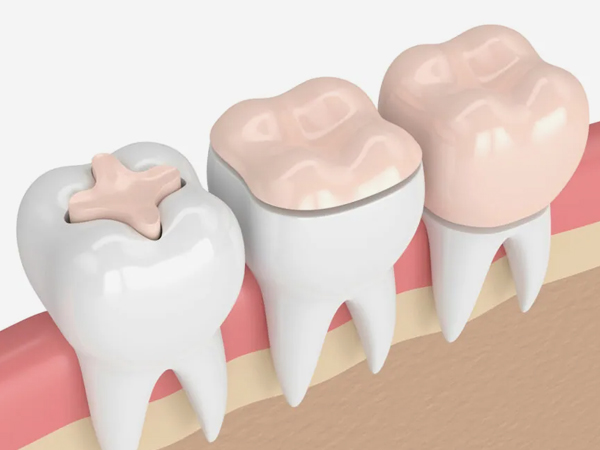Schedule Now

Bigger isn’t always better, especially when it comes to dental restorations. Though dental materials mimic nature better now than ever before, they still serve as second best to healthy, natural tissue. In the best interest of our patients’ health and wellbeing, our Fort Wayne dentists prefer to preserve the optimal amount of natural tooth and gum tissue when placing dental restorations. For many decades, crowns were the only restoration available, when a filling would not provide adequate strength. Crowns require a tooth to be significantly altered, so that they fit snugly in place and look natural among neighboring teeth. Today, we have a conservative alternative to crowns with dental inlays and onlays.
To learn more, visit or call our Fort Wayne, IN, office today at (260) 432-0561 and reserve your appointment with one of our experienced restorative dentists.
When Dental Restorations Are Required
Fillings repair tooth decay that has not compromised a tooth’s structure or root.
Inlays and onlays provide a more durable restoration than fillings, but do not hold a tooth together from the outside. Instead, the fit inside a tooth, like a filling.
Crowns cover the entire enamel-coated portion of a tooth that we see above the gum line. They surround the tooth to wall-up the exterior for excellent structural support. Because of their shape, crowns can repair large fillings, as well as cracks and chips.
Inlays and Onlays
Inlays fit between the cusps on the top of a tooth.
Onlays fit over one or more cusps and may also cover the side of a tooth.
Receiving the Restoration
To determine the most beneficial restoration for your damaged tooth, we will take x-rays and images of the tooth. The dentist will evaluate these images with you, in the treatment room, pointing out specifics about your case. This is the ideal time for you to ask questions and let us know if you have any concerns. Before you leave the diagnostic consultation, the dentist will create a treatment plan and explain what you should expect during and after your procedure(s). Our front office team will work with you on scheduling and financial details.
If the dentist suggests an inlay or onlay, you should plan on attending two clinical appointments to complete the treatment.
Your First Appointment
Your Second Appointment
At the second and final clinical appointment, your lab-made inlay or onlay will have been delivered to our office. In most cases, the restoration is made of ceramic (porcelain), but some situations call for an all-metal or porcelain-fused-to-metal construction. A ceramic inlay or onlay is shaded to blend with existing tooth enamel, for a seamless and inconspicuous appearance.
Again, we will administer anesthetic to ensure your comfort as the dentist performs the final phase of treatment, placement of your restoration. First, the doctor will remove your temporary restoration and clean the tooth. Then, a dental cement will be applied to secure the inlay or onlay in place. After checking your occlusion and making any necessary adjustments, the doctor will provide you with final instructions before you leave the office.
Expect some mild sensitivity the day of and (perhaps) a few days following the placement of your inlay or onlay. Over-the-counter pain reliever, taken according to directions, should resolve lingering discomfort. Your mouth should feel great within a day or two, and you’ll enjoy your new restoration for many years.

